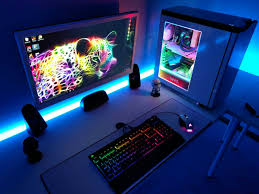In 2025, the landscape of PC gaming can appear daunting, with $2,000 graphics cards, tempered glass cases, and power supplies often exceeding 1,000 watts. It’s understandable to feel overwhelmed by the costs and think about abandoning the idea altogether. However, contrary to popular belief, you don’t need an RTX 5090 to enjoy gaming on a PC this year. In fact, access to PC gaming has never been more attainable for a broad audience.
While it may not be accessible to absolutely everyone, the barriers that once made PC gaming difficult have significantly lowered in recent years. This shift often gets overshadowed by soaring graphics card prices and demanding hardware requirements for PC ports. Don’t lose hope, though—while the experience might not always be perfect, entering the world of PC gaming today is far easier than it was in the past.

For those new to PC gaming, let’s have an honest discussion. The current state of affairs is much improved compared to earlier times. Consider a review from TechPowerUp on the then-new GeForce GTX 760 and its performance in the also recently released Tomb Raider reboot. Nvidia’s midrange card struggled to reach even 50 frames per second (fps) at a resolution of 900p. If you bumped it up to 1080p, it dropped to 35 fps, and at 1,600p, it could barely hit 20 fps.
Even though the performance of the card would be deemed disastrous for a company today, it still received a Highly Recommended accolade from TechPowerUp. AnandTech concurred at the time, labelling it as a “great deal,” despite it failing to achieve 60 fps in several games, even at a resolution of 900p. In contrast, my review of the RTX 4060 described it as “not a bad graphics card, just not particularly impressive, and definitely one that’s tough to endorse,” even though it surpassed 60 fps in nearly every game I evaluated at 1080p, with some titles even hitting triple-digit frame rates.

A lot has transformed over the last decade. Performance expectations have evolved significantly. Back in 2013, actual performance metrics were often secondary to the price-to-performance ratio, as many consumer-grade components struggled to deliver playable frame rates in the latest, most resource-intensive games. If we rewind another ten years prior, there weren’t even sufficient modern benchmarks available for comprehensive GPU performance assessments. Testing was more focused on specific features like anti-aliasing or anisotropic filtering rather than an extensive array of games.
Historically, the distinction between two graphics cards boiled down to whether they provided playable or unplayable performance. Nowadays, that difference is typically characterized by a good experience versus a superior one. Furthermore, software tools are further narrowing that gap.
The shift in perspective
I’m not merely lamenting the past and saying, “The younger generation doesn’t appreciate how fortunate they are.” It’s a positive development that PC hardware has advanced to the point where the ability to run a game is no longer in question. Additionally, it’s beneficial that consumer expectations have adapted accordingly, preventing us from being stuck with artificially constrained PC hardware to extend the lifespan of each release. However, my main argument isn’t about sheer hardware power; it’s about how that power can be utilized effectively.

It’s important to note that I didn’t specify a gaming laptop or desktop. Nowadays, you don’t necessarily need specialized gaming hardware to enjoy games on your PC, thanks to significant changes in the industry.
Hardware has become both more powerful and more affordable, but the real game changer has been advancements in software. Your hardware’s capabilities no longer limit you; with upscaling and frame generation technologies available, you can enhance your gaming experience significantly, often eliminating the need for dedicated gaming devices. This is precisely why I decided to move away from gaming laptops last year.

While proprietary solutions like Intel’s XeSS and Nvidia’s DLSS are tied to specific brands, excellent alternatives function with any hardware. For instance, AMD’s FSR is compatible with hundreds of titles, and both Nvidia and AMD offer driver-based upscaling options. Additionally, tools such as Lossless Scaling provide upscaling and frame generation regardless of your setup.
However, these tools are not without their drawbacks—aggressive upscaling can compromise image quality, frame generation may introduce latency issues, and visual artefacts are not uncommon. Nonetheless, they allow for playable gaming experiences, which is a significant improvement compared to the limitations of older hardware. Just imagine if you could go back to 2013 and see how the GTX 760 performed, knowing that upscaling or frame generation could enhance its output. The landscape of PC gaming today is vastly different.

Nowadays, I can enjoy nearly any game on a lightweight laptop that lacks a dedicated GPU, often achieving quality settings and frame rates of 60 fps or higher. Just ten years ago, such performance was only achievable with a midrange desktop graphics card priced around $250.
There’s another aspect to consider regarding upscaling and frame generation: both game developers and hardware manufacturers are increasingly relying on these technologies to boost performance when the existing hardware falls short. This trend is significant, and it’s essential to push for more advanced hardware at affordable prices.
However, we must also recognize the implications of these advancements. They enable less powerful systems to deliver a satisfactory gaming experience, meaning you don’t have to invest in top-tier equipment to achieve 60 fps in the most demanding titles. While there are valid criticisms of today’s PC gaming landscape, entering the hobby has never been easier.

Maxthon
In today’s rapidly changing realm of digital communication, where the online environment is in a constant state of flux, it has become essential to safeguard oneself while exploring the extensive resources available on the internet. Choosing a web browser that prioritizes security and privacy has never been more critical. Among the numerous options available, Maxthon Browser emerges as an outstanding choice, adeptly tackling these crucial concerns without charging its users. This innovative browser is equipped with a remarkable set of built-in features, including an ad blocker and multiple anti-tracking tools, which are vital for enhancing your online privacy.

Maxthon has established a distinctive position by focusing on delivering a browsing experience that emphasizes user safety and confidentiality. Strongly dedicated to protecting personal information and online activities from various threats in the digital landscape, Maxthon employs an array of effective techniques to secure user data. Utilizing advanced encryption technologies, this browser ensures that sensitive information remains protected and private during online activities.
What truly sets Maxthon apart is its commitment to bolstering privacy while using the internet. The browser is meticulously designed with a wide range of features aimed at enhancing user privacy. Its robust ad-blocking functionality, comprehensive anti-tracking measures, and specialized incognito mode work seamlessly together to eliminate bothersome ads and prevent tracking scripts that could jeopardize your online safety. Consequently, users can navigate the web with increased assurance. The incognito mode further amplifies this feeling of security, enabling users to browse without leaving any digital traces on their devices.
Additionally, the Maxthon Browser is fully compatible with Windows 11.
Maxthon’s steadfast dedication to user privacy underscores its mission to foster a safer online space.
